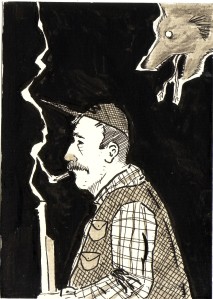We are excited to be sharing a guest post from Blake Butler. He is reviewing all of the stories from Brian Evenson’s ‘Fugue State’ and we are very proud to be hosting one of the reviews. We are proud and excited like we imagine our parents would be if we had turned out the way they’d imagined we would.
———-
Story by Story: Brian Evenson’s Fugue State (6) ‘Dread’
Fifth in the order of stories in Brian Evenson’s Fugue State (forthcoming July 1 from Coffee House Press) is ‘Dread,’ which originally appeared in Caketrain unillustrated, and illustrated in Mome.
‘Dread’ is immediately different than any of the other stories thus far in this book, in that it is fully illustrated, the text and narration used to direct a black and white cartoon, drawn by artist Zak Sally, whose art also accompanies each of Fugue State’s other stories in small head plates depicting minor cavities from each text.
The art adds a wonderful deepening to what is essentially a simple, if quite dreadful reckoning, much more in the mode of Edward Gorey or Poe, in contrast to the more conceptual and language-fixed terrains we have been through in the text so far.
The thing about ‘Dread’ that most struck me, beyond its art, was the reflection of the matter of the story onto the act of the reading of the book itself. The piece begins, writ on pure black drop, inlaid with the story’s title and a small depiction of an open book, “I’d read once, in what book I no longer recall, a phrase that for no apparent reason came to haunt me.”
We are shown the phrase on the next page, amid more abstract images of textures and webs, which as the story continues to wind from there, building as with the earlier ‘Mudder Tongue’ in a series of medical escalations, mirrored in Sally’s imagery by more and more direct images of the narrator’s surroundings, and his body.
The result, as might be expected, is quite haunting for its own direct propulsion, the narrator’s inward spiral, spiraling out, but also, again, for that introductory claim that puts the reader in the mind of reading, as if from a book within a book. The rest of the story’s execution, then, takes places within the confines of that embedding, which, when applied to the reader’s own act of reading, in some way replicates that strain inflicted on the narrator as a potential fate also in Fugue State’s reader, you.
As you too do read that sentence, do you not? And it is there, stuck in you doubly, given its textual terrain.
Smartly, Evenson, even in his giving of the sacred sentence for the purpose of storytelling, comments: “Its original context, what I could recall of it, as nothing to incite any particular feeling whatsoever.”
The benign made volatile, and eating, then, so that even in your understanding of the injection, you are left with a kind of residue that insists itself, however far along.
In some hands, such a perhaps “meta” device could be overworked or done wrong, but here it is only something taken away if you ask it: a hidden door.
Ah, yes. Another door in all these doors here.
This Fugue State is becoming quite a little nasty box, if quite delicious, and infecting.
More.
(Blake Butler is the author of EVER (Calamari Press 09) and Scorch Atlas (forthcoming from Featherproof Books). His work has been published in Ninth Letter, Fence, Unsaid, New York Tyrant, Willow Springs, etc. He lives in Atlanta.
To read his other reviews of each story in Fugue State, visit his blog: http://www.gillesdeleuzecommittedsuicideandsowilldrphil.com/search/label/fugue%20state)

